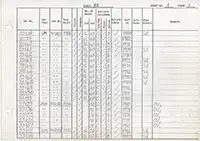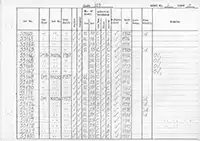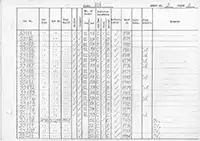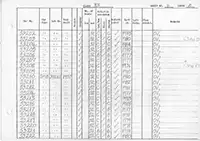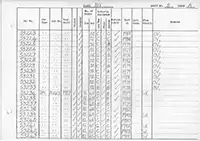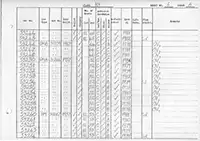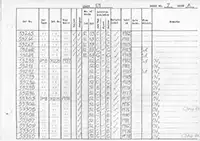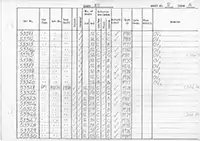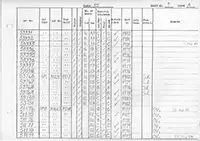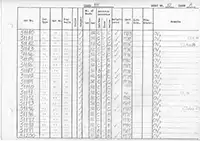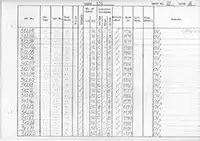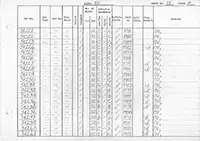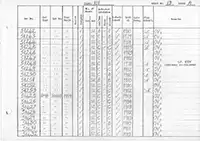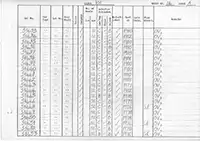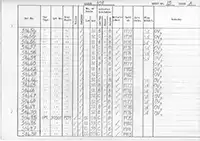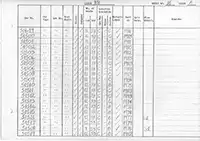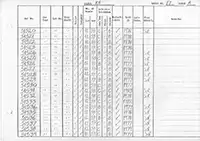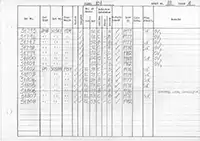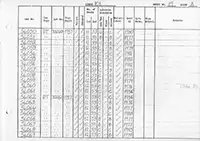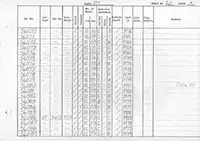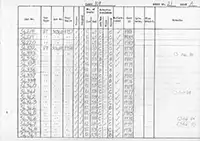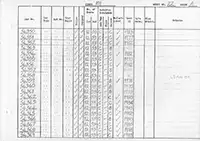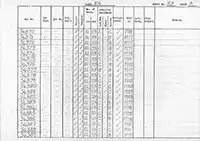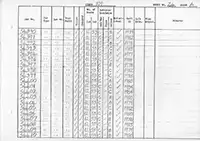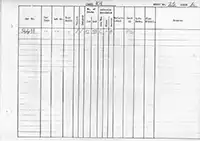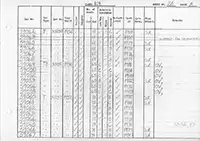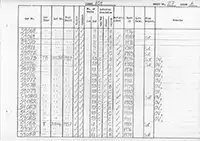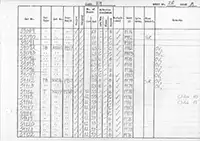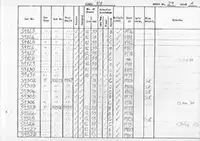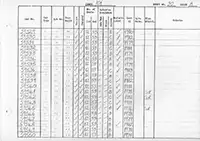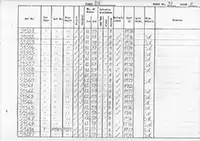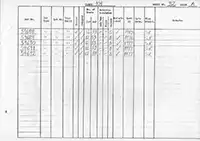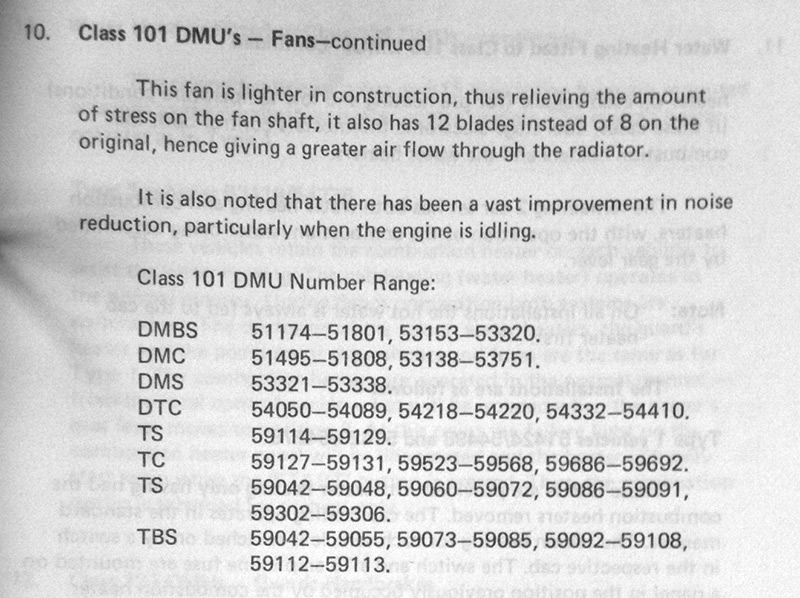Class 101 Met-Camm 2,3 & 4-car DMUs
Modifications
Over the years many modifications would be made to the vehicles.
Vacuum pipes

After production had ceased a vacuum pipe modification was made by the LMR during the mid-1960s when its allocation of units received a modified vacuum release pipe mounted beneath the buffer beam, the train pipe remaining in the original position This led to a one up, one down look, which made Midland cars instantly recognisable from other region's units. This modification was also carried out on four ex-ER based power trailer units (50203/6/8/28 56055/8/60/80) which were acquired by the Midland in exchange for the four LMR Rolls Royce powered sets which moved to the ER at NevilIe Hill depot.
Later three more ex-ER vehicles were equipped with the LMR brake pipe mod; 53168, 53218 and 53164. The latter car was the DMBS in green set 101685, fitted in 1992 after it sustained accident damage to the cab front while allocated to CF as part of set C388, with cars 59387 and 53203, the latter also carrying a modified pipe fitted some 27 years earlier when transferred from the ER to the LMR as part of the exchange mentioned above.
Window Bars Fitted
Vehicles allocated to the north east were fitted with window bars across the passenger door drop lights to prevent accidents to passengers on some restricted clearance routes in that operating area. These were removed from most if not all vehicles by 1980.
Refurbishment
In 1974 a class 101 3-car set was selected as the test bed for the first generation DMU refurbishment scheme, and them many more vehicles were refurbished. For full detail see the refurbishment page.
Re-engining Programme
At the end of 1975 British Rail ordered 300 Leyland 680H diesel engines from Leyland Truck & Bus. The £1¼ million order was to replace the engine in vehicles from Classes 101/119/120. The engine replacement was not part of the refurbishment programme then underway. It was due to the poor availablilty of spares for the original AEC engines.
Delivery commenced in January 1976 at a rate of ten engines a week. They were supplied complete with Leyland fluid couplings and were to drive through the existing mechanical transmissions.
It was quoted that the 680H was the horizontal version of the 680 in use in the majority of London buses, and that for traction use, the engine was de-rated from over 200hp to 181hp, and that even in this de-rated form the new engines provided 20% more power than the previous AEC equipment.
Asbestos Removal
The pages below are from a vehicle log kept by the RTC at Derby dated circa 1984 which included the asbestos status for each vehicle.
The codes for the asbestos columns are: / not built with blue asbestos; B - blue asbestos; and C - removed. In the remarks column OV means open van (no cage).
Headlamps
In early 1982 quartz-halogen headlamps began appearing on the Class as they passed through works. These early sets had the headlamp off-centre, nearer the driver side.
Units transferred to CF in mid-1982 had these fitted by early 1983 for working over the Central Wales line.
Later on, the standard position of the headlamp became central to the two marker lamps.
Radio Electronic Token Block
Ten Norwich based 3 Car sets were equipped for radio electronic token block signalling during the 1980s for East Suffolk line use. The vehicles fitted could be identified by the large vertically mounted antenna attached to the second man's side of the cab front just to the left of the destination box when viewed from the front.
| Set No. | Vehicles | |||
|---|---|---|---|---|
| 92 | 53139 | 59092 | 53238 | |
| 94 | 53266 | 59095 | 53267 | |
| 95 | 53168 | 59079 | 53177 | |
| 100 | 53305 | 59536 | 53150 | |
| 101 | 53315 | 59118 | 53330 | |
| 102 | 53180 | 59055 | 53193 | |
| 103 | 53149 | 59077 | 53170 | |
| 104 | 51506 | 59804 | 51508 | |
| 105 | 53181 | 59085 | 53321 |
The details above are from 1986. Norwich swapped vehicles and set numbers frequently.
After dispersal of these units some vehicles could be seen at depots such as Laira (LA) still sporting the antenna mounting bracket, which projected forward from the cab front.
Observation Saloon
In 1987 DTC 54356 was selected for use as an observation car to work trains from Inverness to Kyle Of Lochalsh. Repainted in Highland green and cream and numbered 6300 it was fitted with luxury random seating, ETH and new sealed window units.
Extra Luggage Space
During the 1980s vehicles allocated to Reading were fitted with additional luggage space for working Reading - Redhill services which serviced passenengers from both Heathrow & Gatwick. This reduced seating capacity by 12 seats per 3-car set.

DMBC
In the late 1980s 53155 became a unique Class 101 DMBC when first class was added to the front saloon when it was part of NSE set L211.
The images shows the vehicle at Reading on 6/11/91. Sparegang.
Facelifted Regional Railways Units
In 1991 the first 'Facelifted' Class 101s made their appearance. This was a C3T life-extension and all were treated at Doncaster Works. The majority were released in Regional Railways livery (the only Class 101s to carry this), initial allocations were to Norwich Crown Point (NC), Cambridge (CA), Longsight (LO), Laira (LA), Tyseley (TS), Haymarket (HA) and Corkerhill (CK) &mdash the Corkerhill units being painted in Strathclyde PTE Orange and Black.
All driving cars carried six digit set numbers below each drivers window at both ends of the set, in the 101 6xx series. The power-trailer sets were 101651-665, the power twins / three-cars were 101676-695.
Cab to shore radio telephones were fitted in the driving cabs with dish antennas fitted to the cab roof. Most DTS vehicles were re-seated in 2 + 3 configuration in the former first class areas of the cars, now seating 72 second.
By 1994 all vehicles were concentrated on either LO or CK, by the end of 2000 all were at LO.
Misc
Latterly two further modifications were been made to Regional Railways 101s. The standard drivers windscreen was replaced with thicker laminated glazing and heavy retaining moulding.
The other feature was the fitting of 18" diameter Oleo long shanked buffers in place of the original style shorter and broader shanked Met Camm type and the removal of the buffer mounting stubbs which are no longer required for the longer buffers, only a few vehicles have received this modification.
This image shows the standardised front end changes which removed the 2-character route indicators or extra lamps. The refurbished set on the right was probably one of the first vehicles to originally have the 2-character route indicator fitted and delivered with the top lamp cut-out crudely plated over. Note that it also carries a tail lamp, meaning red bulbs have not yet been fitted to the marker lamps. Taken in Sheffield, 1st March 1980. Graham Turner.
Radiator Fans
Here are details of one of the many other modifications made to the class, detailed in LMR Traction Bulletin Issue 38 (March 1984).
Summary
Orders
Batches
Description - Technical
Description - Interior
Description - Variations
Description - Modifications
Met-Camm Adverts
Diagrams
Drivers Instructions
Refurbishment
Numbering
Liveries
Operations - Initial
Operations - Later
Operations - Scottish Region
Accidents
Daisy - 101685
Observation Saloon 6300
Parcel Use
Departmental Use
Images
Details about preserved Class 101s can be found here.
Many thanks to Mac Winfield and Eddie Knorn for their assistance in the preparation of this section.



